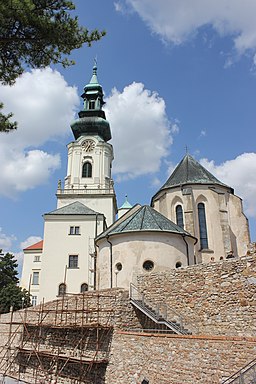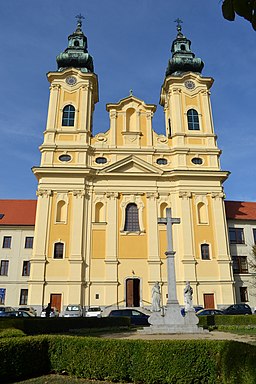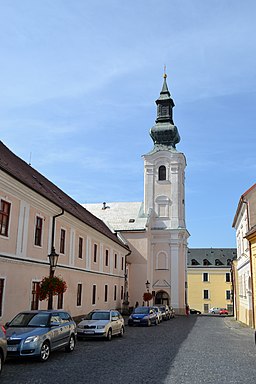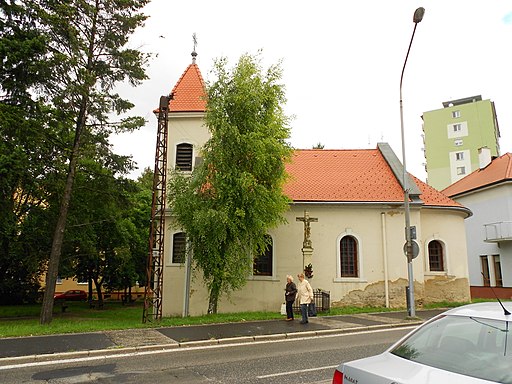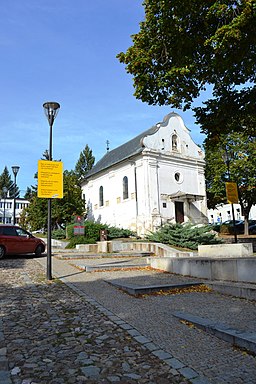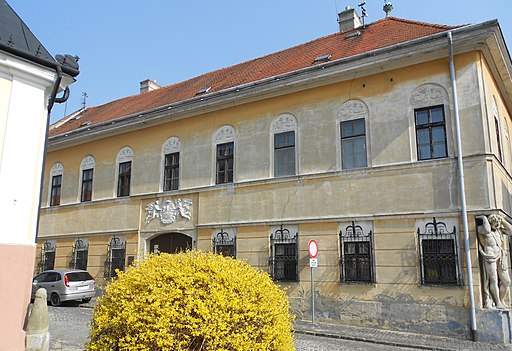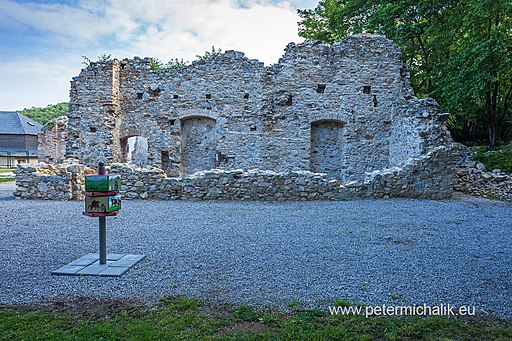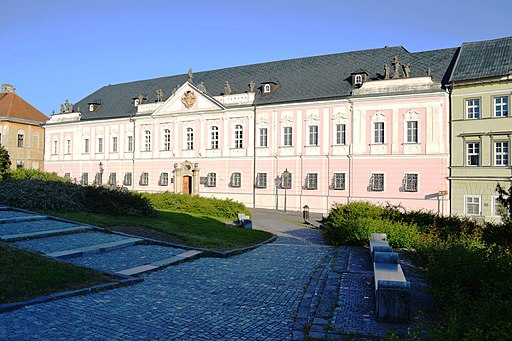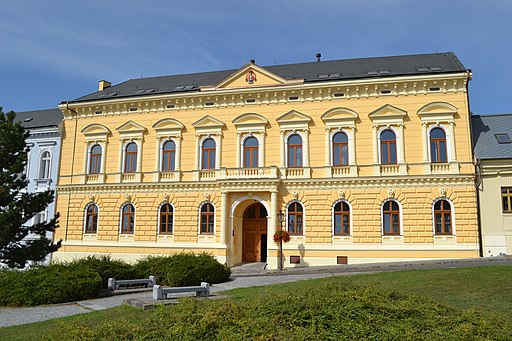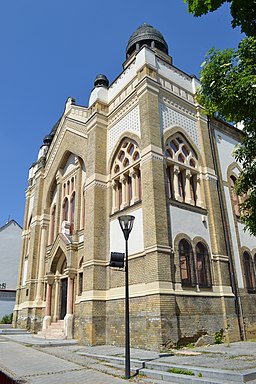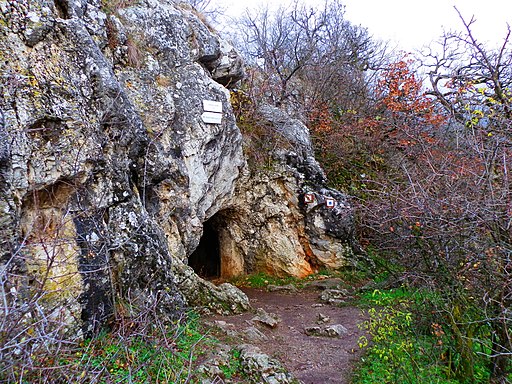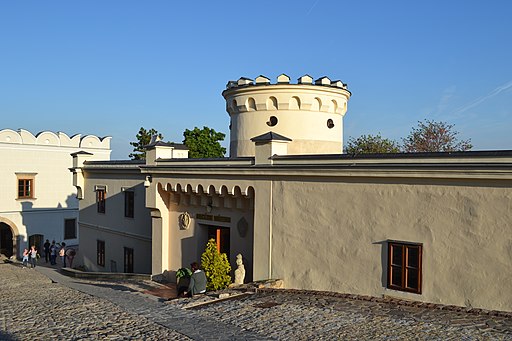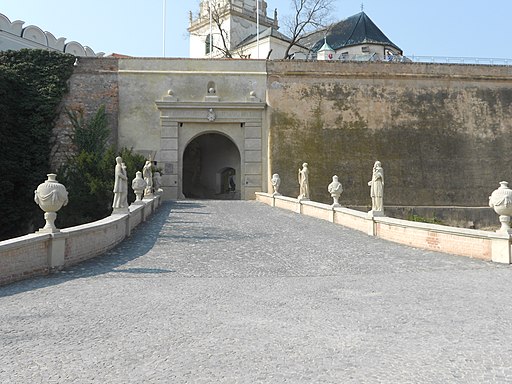Nyitra
| Total | 16419 |
|---|---|
| Hungarian | 59.4% |
| German | 9.9% |
| Slovak | 30% |
The town that took its name from the Nyitra River was an important episcopal seat and also the seat of the former Nyitra County and played an important role in the early history of Hungary. The pagan rival of Stephen I, the first Christian king of Hungary, named Vazul was held captive and blinded in its castle. The Bavarian Gisela, the wife of Stephen I, established the predecessor of the present-day cathedral and dedicated it to St. Emmeram, the patron saint of Regensburg. The monastery on Mount Zobor was also founded at that time under the patronage of the Bavarian saint Hippolyte. Nyitra was the seat of the Duchy that was traditionally held by the ruling king's younger brother. Since the dukes often aspired to the throne, this institution was abolished by King Kálmán the Book-Lover, who also established the Bishopric of Nyitra in 1113 and constructed the first stone castle here. The monument erected in 1896 for the Millennium of Hungary was exploded by the Czechoslovak invaders in 1921, but its magnificent pedestal still stands on Mount Zobor next to the radio transmitter. The former Hungarian majority of the town was swept away by the persecutions during the 20th century, but they left behind an indelible mark in the cultural heritage of the town.
Check out other towns in Upper Hungary (Slovakia) as well!
The first church dedicated to St. Emmeram of Regensburg was built at the beginning of the 11th century under the patronage of the Bavarian Gisela, the wife of King Stephen I of Hungary. St. Emmeram was a bishop and martyr, who died in Regensburg, Bavaria.
At the beginning of the 12th century King Kálmán I of Hungary established the diocese of Nyitra. A round church was built in 1158 in Romanesque style. The Upper Church was built between 1333 and 1335 in Gothic style and was modified at the beginning of the 18th century. In addition to this, Bishop Telegdi János of Nyitra built a large Baroque dome between 1621 and 1642, which became the Lower Church. The Chapel of St. Barbara was also added to the Upper Church at that time.
The main altar is adorned by the statues of two saint kings of Hungary, St. Stephen and St. László. On the relief above the chapel of the bishop, St. László can be seen. The statue of St. Emmeram is the oldest statue in present-day Slovakia. The bones of the guardian saints of the cathedral, St. Zoerard-András (Andrew Zorard) and St. Benedict of Szkalka, rest in a coffin made in 1674.
The medieval Gothic building was reconstructed in Baroque style by Bishop Erdődy between 1732 and 1739. The statue of Pope John Paul II from 2012 stands before the palace.
The church was standing already in 1446. It was fully reconstructed between 1723 and 1738. The statue of Our Lady of Sorrows on the main altar was made before 1784. It is a place for gaining indulgence.
The construction started in 1852 at the initiative of Bishop Palugyay Imre. The church was completed in 1861 in neo-Romanesque style. The main altar depicts Saint Imre, Saint Vincent de Paul, Virgin Mary and Saint Elisabeth.
The feast of Virgin Mary of the Sickle is held in memory of the event when the pregnant Mary visited Elisabeth, who was also pregnant with John the Baptist. The liturgical name of the holiday is "The visitation of the Blessed Virgin Mary". It was traditionally held on July 2 from the 13th century. Later the Second Vatican Council (1962-65) modified the date to May 31. But in Hungary it is still held on July 2, and since this day is also the beginning of the harvest season, the feast bears the name "Virgin Mary of the Sickle" in Hungary.
The Piarist Order arrived in Nyitra in 1698 in order to teach poor children. The monastery was built between 1701 and 1702. Between 1702 and 1741 a complex consisting of a church, a grammar school and a college was built from the contributions of Bishop Mattyasovszky László and others. The church that can be seen today was constructed between 1742 and 1789 at the initiative of the rector Nemcsényi Adolf.
The Piarist grammar school of Nyitra operated from 1698 to 1919. In 1919 the Czechoslovak invaders drove away the Piarists and expropriated the buildings. In 1992 the Piarists recovered the buildings and opened a grammar school.
After 1940 the church was marred by ahistorical and inappropriate frescos. These depict the factionary church of Pribina (the prince of Nyitra of unknown origin in the first half of the 9th century), the arrival of Cyril and Methodius in the Great Moravian "Empire", and the inauguration of two Slovak bishops in 1921 after the Czechoslovak invasion of northern Hungary.
It was built between 1624 and 1634 in Renaissance style by Bishop Telegdi János of Nyitra. It was reconstructed in Baroque style in 1763. The 33 reliefs illustrating the life of St. Francis of Assisi were made around 1760. The reliefs on the facade from 1633 depict St. Peter and St. Paul.
It was built in 1910 in neo-Renaissance style according to the plans of Gere József.
It is the oldest church of the town. It was built in the 10th century in Romanesque style. A Gothic sacristy was built in the 13th-14th century. At the beginning of the 18th century Bishop Mattyasovszky László reconstructed the church in Baroque style.
The chapel was built by Bezovics Lukács in 1739. Bishop Bende Imre reconstructed it in 1894, and its tower was demolished. The statue of St. Michael the Archangel was made by the sculptor Bártfay Gyula in 1930.
The Calvary was built in the last third of the 19th century with 7 stations. In 1885 another 7 stations were added at the initiative of Bishop Roskoványi Ágoston. The chapel was dedicated to the Holy Sepulcher.
It was built between 1818 and 1821 in Empire style by Bishop Kluch József of Nyitra for the canons. The statue of Atlantis on the corner of the building was carved by Master Lőrinc in 1820. The locals called it Corgony. According to the legend Corgony was a smith, who was so strong, that he alone defended the Upper Town against the Turks. The beer of Nyitra was named after the statue.
Mount Zobor is 587 meters high and is the southernmost point of the Tribecs Mountain. Only the ruins of the abbey can be seen, and the area is occupied by a sanatorium.
The Benedictine monastery dedicated to St. Hippolit was established during the reign of St. Stephen of Hungary (1000-1038). St. Hippolit was a Bavarian saint venerated in the circles of the Bavarian Queen Gisela, the wife of King Stephen. The most famous hermits of the monastery were Saint Zoerard-András (Andrew Zorard) and his disciple Saint Benedict of Szkalka. Saint Zoerard-András lived in the cave of Mount Szkalka, which rises steeply above the banks of the Vág River. He died of asceticism in 1009. His friend, Benedict moved to the cave after his death. Benedict was attacked by bandits in 1012. As they didn't find anything valuable in his cave, they killed him, dragged his body down to the banks of the Vág River and threw it into the fast-running water. According to the legend an eagle floating steadfastly above the water helped to find his body, which was in perfect condition. He was transported to Nyitra and was buried beside Saint Zoerard-András.
They were ordained saints on July 17, 1083 during the reign of St. László of Hungary together with King Stephen, Prince Imre and Bishop Gellért. Their feast is on July 17. Jakab, the bishop of Nyitra, established a Benedictine Abbey in 1224 at the cave of Szkalka.
The Abbey on Mount Zobor was either taken from the Benedictines by the Archbishop of Esztergom in 1464 or occupied by Archbishop Vitéz János in 1471, after he betrayed King Matthias of Hungary. In 1695 Camaldolese monks from Italy settled down and they built a new church and a monastery that was abandoned in 1782.
The Great Seminary was built in the second half of the 18th century. The Chapel of St. László can be found upstairs. Its library was founded in 1771, it is the 3rd largest library of present-day Slovakia. It has 66 thousand books mostly in Latin, Hungarian and German language. The northeastern wing of the Great Seminary was turned into a library of the diocese between 1877 and 1878 at the initiative of Bishop Roskoványi Ágoston.
The Small Seminary was built at the beginning of the 18th century on medieval foundations. It was given an eclectic appearance between 1876 and 1884. It is now the home of the Seminary of St. Gozard.
The synagogue was built between 1908 and 1911 in Orientalist style according to the plans of Baumhorn Lipót.
It was built in 1784. It was reconstructed in neo-Baroque style around 1874. There was another reconstruction between 1905 and 1908 in Art-Nouveau style led by the architect Czigler Győző.
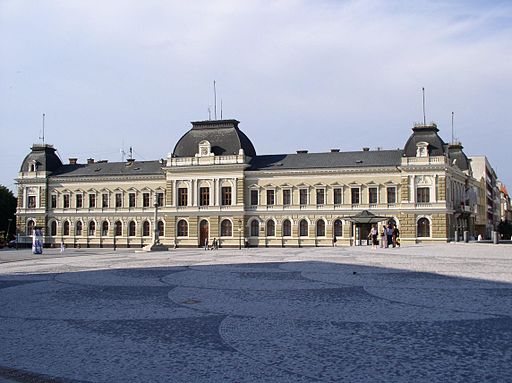
The teachers and students of the Piarist grammar school started to collect the materials for the museum in the middle of the 19th century. The Museum of Nyitra County was established in 1896. The museum was closed in 1951. It was reopened in 1962 in the building of the Great Seminary. Now it is situated in the building of the former town hall.
The construction of the town hall started in 1880 in neo-Renaissance style according to the plans of the architect Lyka János from Nyitra.
It was built between 1901 and 1903 according to the plans of Kiss István.
The casemates were created in 1664 during the Turkish wars. Bishop Pálffy Tamás built a new wall to the southern side of the bastion. The space between the wall and the bastion was not filled in, but archs were created between the structures and the castle gate was defended from here through loopholes.
Vazul was blinded here in 1037 at the command of King Stephen I of Hungary. Vazul did not accept, that the King named his son Imre as his heir instead of him, because according to the ancient Hungarian tradition the oldest family member was to succeed in power. The tower itself was constructed later. The former castle dungeon is located under the tower. The castle well was 60 meters deep.
The Baroque bridge was built between 1750 and 1780 using bricks. The castle could be accessed through this bridge. At the end of the 19th century the bridge was reinforced with new piers and the arches were walled. During a reconstruction in 2011 the entrepreneur partially demolished the bridge.
The monument stood a few meters to the south of the current TV tower. Its pedestal is still there. The monument was erected in 1896 according to the plans of Berczik Gyula in memory of the 1000th anniversary of Hungary. It was 22 meters high. It consisted of an obelisk and four turul birds, one facing each direction.
According to the Gesta Hungarorum written by Anonymus, the notary of King Béla III of Hungary, the Hungarians under the command of Huba, Szovárd and Kadocsa defeated Zobor, the leader of the Moravians, here and afterwards they hanged him on top of Mount Zobor. But according to the historians the character of Zobor was only invented by Anonymus.
The Czechoslovak invaders of the town exploded the monument in 1921.
The monument stands in the park under the castle. It was erected in 1918 in memory of the soldiers of the 14th Hungarian infantry regiment of Nyitra who died a heroic death in World War I. It is the artwork of Finta Sándor. Its original Hungarian inscription was replaced by a Slovak one after the Czechoslovak invasion of the town.
It was erected next to the stairs leading to the castle gate in 1750. The sculptor was Vogerl Márton. The statue was raised by Archbishop Esterházy Imre of Esztergom in memory of the plagues in 1710 and in 1739. On the four corners of its pedestal the statues of Hungarian kings stand: St. Stephen, St. László, St. Imre and Béla IV.
The synagogue was built between 1908 and 1911 in Orientalist style according to the plans of Baumhorn Lipót.
It was built in 1784. It was reconstructed in neo-Baroque style around 1874. There was another reconstruction between 1905 and 1908 in Art-Nouveau style led by the architect Czigler Győző.

The teachers and students of the Piarist grammar school started to collect the materials for the museum in the middle of the 19th century. The Museum of Nyitra County was established in 1896. The museum was closed in 1951. It was reopened in 1962 in the building of the Great Seminary. Now it is situated in the building of the former town hall.
The construction of the town hall started in 1880 in neo-Renaissance style according to the plans of the architect Lyka János from Nyitra.
The casemates were created in 1664 during the Turkish wars. Bishop Pálffy Tamás built a new wall to the southern side of the bastion. The space between the wall and the bastion was not filled in, but archs were created between the structures and the castle gate was defended from here through loopholes.
Vazul was blinded here in 1037 at the command of King Stephen I of Hungary. Vazul did not accept, that the King named his son Imre as his heir instead of him, because according to the ancient Hungarian tradition the oldest family member was to succeed in power. The tower itself was constructed later. The former castle dungeon is located under the tower. The castle well was 60 meters deep.




